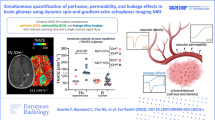Summary
This is a review of recent work in23Na MR imaging. The main emphasis of recent papers has been pulse sequences that, with appropriate postprocessing, give images of the fast, slow, and intermediate components of T2 decay. The assignment of compartmental designation to the T2 component remains a problem except for homogeneous structures easily identifiable anatomically (ventricles, superior sagittal sinus, globe of the eye). Compartmental distribution of sodium is described. The predominance of the interstitial and plasma compartment, the invisibility of part of the intracellular sodium, and the difficulty in imaging the very fast T2 component of visible intracellular sodium make the usual Na spin-echo image essentially an image of the interstitial and plasma space. Use of super paramagnetic iron oxide coupled to dextran as a contrast medium may help to identify the plasma compartment. Because the usual Na MR images are essentially interstitial and plasma images, our own interest is in observing functional changes in these compartments. Another proposed application is the detection of the very fast T2 component in brain tumors to aid in defining tumor grade and extent.
Similar content being viewed by others
References
Hilal SK, Maudsley AA, Simon HE, Perman WH, Bonn J, Mawad ME, Silver AJ, Ganti SR, Sane P, Chien IC (1983) Invivo NMR imaging of tissue sodium in the intact cat before and after acute cerebral stroke. AJNR 4:245–249
Hilal SK, Maudsley AA, Ra JB, Simon HE, Roschmann P, Wittekoek S, Cho ZH, Mun IK (1985) In vivo NMR imaging of sodium-23 in the human head. J Comput Assist Tomogr 9: 1–7
Perman WH, Turski P, Houston L, Glover GH, Hayes CE (1986) Methodology of in vivo human sodium NMR imaging at 1.5 Tesla. Radiology 160:811–820
Burstein D, Fossel ET (1987) Intracellular sodium and lithium NMR relaxation times in the perfused frog heart. Magn Reson Med 4:261–273
Hilal SK, Ra JB, Oh CH, Mun IK, Einstein SG, Roschmann P (1987) Sodium imaging. In: Stark DD, Bradley WG (eds) Magnetic resonance imaging. Mosby, St. Louis, pp 715–731
Turski PA, Perman WH, Houston L, Winkler SS (1988) Clinical and experimental sodium magnetic resonance imaging. Radiol Clin North Am 26:861–871
Siesjö BK, Deshpande JK (1987) Electrolyte shifts between brain and plasma in hypoglycemic coma. J Cereb Blood Flow Metab 7:789–793
Young W, Rappaport ZH, Chalif DH, Flamm ES (1987) Regional brain sodium, potassium, and water changes in the rat middle cerebral artery occlusion model of ischemia. Stroke 18: 751–759
Levin VA, Fenstermacher JD, Patlak CS (1970) Sucrose and inulin space measurements of the cerebral cortex in four mammalian species. Am J Physiol 219:1528–1533
Pelligrino DA, Musch TI, Dempsey JA (1981) Interregional differences in brain intracellular pH and water compartmentation during acute normoxic and hypoxic hypocapnia in the anesthetized dog. Brain Res 214:387–404
Weiss HR, Buchweitz E, Murtha TJ, Auletta M (1982) Quantitative regional determination of morphometric indices of the total and perfused capillary network in the rat brain. Circ Res 51: 494–503
Sakai AK, Nakazawa K, Tazaki Y, Ishii K, Hino H, Igarashi H, Kanda K (1985) Regional cerebral blood volume and hematocrit measured in normal human volunteers by single photon emission computed tomography. J Cereb Blood Flow Metab 5:207–213
Perman WH, Thomasson DM, Bernstein MA, Turski P (1989) Multiple short echo 2.5 ms quantitation of in vivo sodium T2 relaxation. Magn Reson Med 9:153–160
Ra JB, Hilal SK, Oh CH (1989) An algorithm for magnetic resonance imaging of the short T2 fraction of sodium using the FID signal. J Comput Assist Tomogr 13:1–8
Winkler SS, Thomasson DM, Sherwood K, Perman WH (1989) RegionalT 2 and sodium concentration estimates in the normal human brain by sodium-23 MRI at 1.5 T. J Comput Assit Tomogr 13:561–566
Hilal SK, Oh CH, Mun IK, Johnson G (1989) Grading of gliomas by sodium MRI (abstract). Proc Soc Magn Reson Med, Berkeley, CA, p 83
Gupta RK, Gupta P (1982) Direct observation of resolved resonances from intra and extracellular sodium-23 in NMR studies of intact cells and tissues using dysprosium (III) tripolyphosphate as paramagnetic shift reagent. J Magn Reson 4:344–350
Summers RM, Joseph PM, Renshaw PF, Kundel HL (1988) Dextran magnetite: a contrast agent for sodium-23 MRI. Magn Reson Med 8:427–439
Bogdan A, Lancaster L, Kundel H (1989) Sodium MRI of extravascular lung water using coated magnetite particles (abstract). Proc Soc Magn Reson Med, Berkeley, CA, p 663
Stark DD, Weissleder R, Elizondo G, Hahn PF, Saini S, Todd LE, Wittenberg J, Ferrucci JT (1988) Superparamagnetic iron oxide: clinical application as a contrast agent for MR imaging of the liver. Radiology 168:297–301
Author information
Authors and Affiliations
Additional information
Supported in part by the Department of Veterans Affairs Medical Research Service
Rights and permissions
About this article
Cite this article
Winkler, S.S. Sodium-23 magnetic resonance brain imaging. Neuroradiology 32, 416–420 (1990). https://doi.org/10.1007/BF00588475
Issue Date:
DOI: https://doi.org/10.1007/BF00588475




